A farmer was having a field in the form of a parallelogram PQRS. She took any point A on RS and joined it to points P and Q.In how many parts the field is divided ? What are the shapes of these parts ? The farmer wants to sow wheat and pulses in equal portions of the field separately. How should she do it ?Solution in Punjabi
Step by step video & image solution for A farmer was having a field in the form of a parallelogram PQRS. She took any point A on RS and joined it to points P and Q.In how many parts the field is divided ? What are the shapes of these parts ? The farmer wants to sow wheat and pulses in equal portions of the field separately. How should she do it ? by Maths experts to help you in doubts & scoring excellent marks in Class 9 exams.
Topper's Solved these Questions
Similar Questions
In Fig. 9.13, ABCD is a parallelogram and EFCD is a rectangle. Also, AL⊥DC. Prove that (i) ar (ABCD) = ar (EFCD) (ii) ar (ABCD) = DC × AL
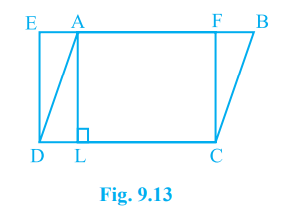 05:47View Solution
05:47View SolutionGiven an arc of a circle, complete the circle.
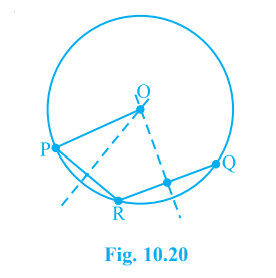 09:32View Solution
09:32View SolutionA farmer was having a field in the form of a parallelogram PQRS. She took any point Aon RS and joined it to points P and Q. In how many parts the fields is divided? Whatare the shapes of these parts? The farmer wants to sow wheat and pulses in equalportions of the field separately. How should she do it?
04:44View SolutionA farmer was having a field in the form of a parallelogram PQRS She took any point A on RS and joined it to points P and Q In how many parts the field is divided? What are the shapes of the these parts? The farmer wants to sow wheat and pulses in equal proportion of the field separately How should she do it?
05:20View Solutionएक किसान के पास समांतर चतुर्भुज PQRS के रूप का एक खेत था। उसने RS पर स्थित कोई बिंदु A लिया और उसे P और Q से मिला दिया खेत कितने भागों में विभाजित हो गया है ? वह किसान खेत में गेहू और दाले बराबर - बराबर भागों में अलग - अलग बोना चाहती है । वह ऐसा कैसे करे ?
04:08View Solutionएक किसान के पास समांतर चतुर्भुज PQRS के रूप का खेल था। उसने RS पर स्थित कोई बिन्दु A लिया और उस P और Q से मिला दिया। खेत कितने भागो में विभाजित हो गया है ? इन भागो के आकार क्या है ? वह किसान खेत में गेहूँ और दालें बराबर - बराबर भागो में अलग - अलग बोना चाहती है। वह ऐसा कैसे करे ?
04:45View Solutionएक किसान के पास समांतर चतुर्भुज PQRS के रूप का एक खेत था|उसने RS पर स्थित कोई बिंदु T लिए और उसे P और Q से मिला दिया खेत कितने भागों में विभाजित हो गया है ? इन भागों के आकार क्या है ? वह किसान खेत में गेहूं और दालें बराबर -बराबर भागों में अलग-अलग बोना चाहती है|वह ऐसा कैसे करें?
05:13View SolutionA farmer was having a field in the form of a parallelogram PQRS. She took any point A on RS and joined it to points P and Q. In how many parts the fields is divided? What are the shapes of these parts? The farmer wants to sow wheat and pulses in equal portions of the field separately. how should she do it?
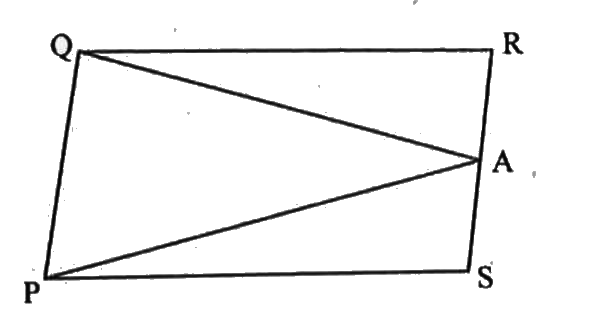 05:24View Solution
05:24View SolutionA farmer was having a field in the form of a parallelogram PQRS . She took any point A on RS and joined it to the points P and Q. In how many parts the fileds is divided ? What ar the shapes of these parts ? The farmer wants to sow wheat and pulses in equal portions of the filed separately, How should she do it ?
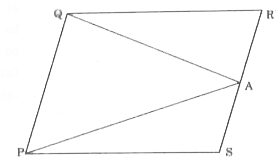 08:03View Solution
08:03View SolutionThe farmer's yard is in the shape of a parallelogram PQRS. She identified the point A on the RS side and added it to the P and Q vertices. How much is the yard divided into parts? What is the shape of these parts? If the farmer wants to sow wheat and corn separately in equal parts, how can she do so?
05:06View SolutionThe field is PQRS horizontal quadrilateral as shown in a farmer map. The center point on the shoulder connects points A to P, Q. How many parts is the farm divided into? What parts are in what shape? If the farmer wants to plant his and the peanut crop in equal parts in his field, how will he plant it? Give reasons.
08:42View SolutionA farmer has a field in the form of a parallelogram PQRS as shown in the figure. He took the mid- point A on RS and joined it to points P and Q. In how many parts of field is divided? What are the shapes of these parts ?
The farmer wants to sow groundnuts which are equal to the sum of pulses and paddy. How should he sow? State reasons?
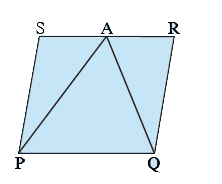 08:31View Solution
08:31View SolutionA farmer has a field in the form of a parallelogram PQRS as shown in the figure. He took the mid- point A on RS and joined it to points P and Q. In how many parts of field is divided? What are the shapes of these parts ?
The farmer wants to sow groundnuts which are equal to the sum of pulses and paddy. How should he sow? State reasons?
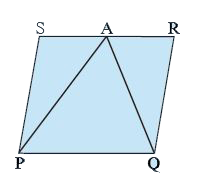 02:32View Solution
02:32View SolutionA farmer has a field in the form of a parallelogram PQRS as shown in the figure. He took the mid- point A on RS and joined it to points P and Q. In how many parts of field is divided? What are the shapes of these parts ?
The farmer wants to sow groundnuts which are equal to the sum of pulses and paddy. How should he sow? State reasons?
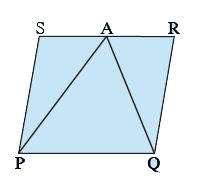 06:10View Solution
06:10View SolutionA farmer was having a field in the form of a parallelogram PQRS. She took any point Aon RS and joined it to points P and Q. In how many parts the fields is divided? Whatare the shapes of these parts? The farmer wants to sow wheat and pulses in equalportions of the field separately. How should she do it?
06:53View SolutionA farmer was having a field in the form of a parallelogram PQRS. She took any point A on RS and joined it to points P and Q.In how many parts the field is divided ? What are the shapes of these parts ? The farmer wants to sow wheat and pulses in equal portions of the field separately. How should she do it ?
01:57View Solution

